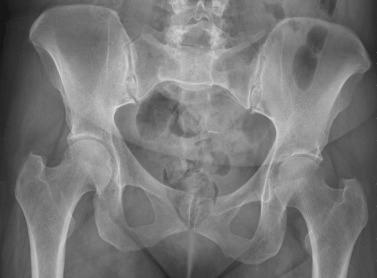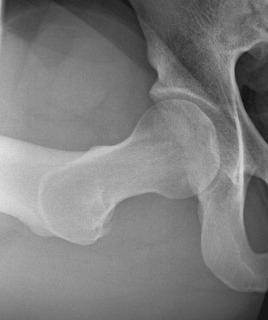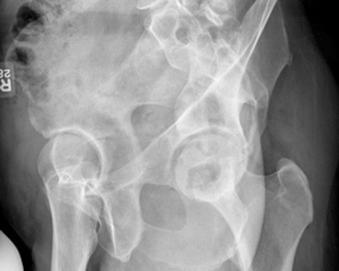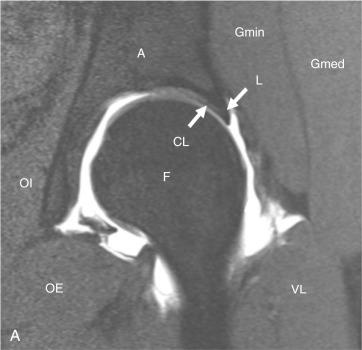Physical Address
304 North Cardinal St.
Dorchester Center, MA 02124
A broad spectrum of radiologic investigations can be used to provide the orthopedic surgeon with important information regarding hip anatomy and pathology, facilitating diagnosis, monitoring, and treatment planning for hip disease.
Radiography is the first line of imaging in investigating the hip; various techniques and projections are used to optimize visualization of select structures and regions of the hip joint.
Femoroacetabular impingement results from anatomic abnormalities of the acetabulum (pincer) and/or the femoral head-neck junction (cam). Radiography and magnetic resonance imaging can effectively demonstrate the primary anatomic deformities, as well as the secondary joint derangements that ensue with femoroacetabular impingement.
Developmental dysplasia of the hip is characterized by an underdeveloped acetabular fossa, which predisposes to hip instability and osteoarthritis. Radiography is the primary modality for characterizing and quantifying the degree of dysplasia and in evaluating for osteoarthritis.
Magnetic resonance imaging is a robust imaging modality for detecting and characterizing a broad spectrum of hip pathologies, including ischemic, traumatic, inflammatory, arthritic, and neoplastic causes.
Radiologic investigation of the hip has rapidly evolved through advances in technology and in knowledge about the causes and physiology of hip disease. In situations where the clinical history and physical examination findings are equivocal, orthopedic diagnosis and management of hip disorders often require adjuvant radiologic evidence of disease before treatment and intervention are begun. Today, several imaging modalities are available to physicians; each modality has a multitude of variations and protocols that can be optimized according to the patient profile, the clinical scenario, and the nature of the hip pathology. It is important for the orthopedic surgeon, radiologist, rheumatologist, physiatrist, and all other allied musculoskeletal specialists to understand the basic principles of hip imaging. Knowledge of the strengths and limitations of the various available radiologic modalities can facilitate and expedite efficient diagnosis and management of hip pathology.
The various imaging modalities are compared in Table 29.1 .
| Conventional Radiography | Computed Tomography | Magnetic Resonance Imaging | Ultrasound | Nuclear Medicine | |
|---|---|---|---|---|---|
| Flexibility in position | H | I | L | H | L |
| Patient tolerance (claustrophobia) | H | H | I | H | I |
| Radiation | L | H | None | None | I |
| Spatial resolution | H | H | I | H | L |
| Contrast resolution | L | I | H | L | L |
| Evaluation of bone, mineralized structures | H | H | I | L | H |
| Evaluation of soft tissues | L | I | H | I | L |
| Accessibility | H | H | I | H | I |
| Relative cost | L | I | H | I | H |
| Acquisition time | L | I | H | I | H |
Radiography is the first line of imaging for the investigation of all hip pathologies, because it can demonstrate gross osseous alignment, morphology, and integrity. The advantages of plain radiography include ease of access, rapid acquisition, lack of any post processing, and flexibility in patient positioning. However, the shape, contour, and spatial relationships of bones may not be demonstrated by radiography to the same degree as by cross-sectional modalities such as computed tomography (CT) and magnetic resonance imaging ( MRI ). Radiography is also limited by its inability to demonstrate internal joint structures, including the cartilage, labrum, capsule, and surrounding periarticular soft tissues.
Many radiographic projections can be used in the investigation of the hip; these views are variably selected depending on the nature of the pathology and on the anatomic regions of concern. Standard imaging protocols have been established to ensure consistent positioning and optimal visualization of regions of interest.
Positioning: Patient supine (standing for dysplasia); feet internal rotation 15 degrees ( Fig. 29.1 )

X-ray technique: x-ray beam perpendicular to table, centered at the midpoint between the superior margin of the symphysis pubis and at the midpoint between the anterior superior iliac spines
Structures of interest: bilateral hips, sacrum, innominate bones, proximal femurs, anterior column, posterior column, anterior and posterior acetabular rims, medial acetabular wall; acetabular version, dysplasia
Indications: all pathologies, including trauma, congenital dysmorphisms, and arthritis
Positioning: anterior oblique 45 degrees/posterior oblique 45 degrees
X-ray technique: x-ray beam directed perpendicular to the table centered at the hip joint
Structures of interest: anterior (iliopubic) column and posterior acetabular rim/posterior (ilioischial) column, anterior acetabular rim, quadrilateral plate
Indications: trauma, fracture
Positioning: patient supine, knee flexed 30 degrees, thigh abducted 45 degrees
X-ray technique: x-ray beam directed perpendicular to the table centered at the midpoint between the ipsilateral anterior superior iliac spine and the superior margin of the symphysis pubis
Structures of interest: proximal femur (head, neck, shaft)
Indications: trauma, fracture
Positioning: patient supine; femur of hip of interest internally rotated 15 degrees, contralateral hip and knee flexed beyond 80 degrees
X-ray technique: x-ray beam directed parallel to table, oriented 45 degrees cephalad from inferomedial to superolateral, centered at the femoral head
Structures of interest: femoral neck and head in lateral projection
Indications: trauma, fracture, when patient unable to position for frog-leg lateral
Positioning: patient supine; symptomatic hip flexed 45 or 90 degrees, abducted 20 degrees, neutral rotation ( Fig. 29.2 )

X-ray technique: x-ray beam in an anteroposterior (AP) direction, centered at midpoint between anterior superior iliac spine and superior margin of symphysis pubis
Structures of interest: femoral head, neck; optimally evaluates head-neck junction for cam femoroacetabular impingement ( FAI ) deformity; anterosuperior hip joint space
Indications: FAI (cam)
Positioning: patient standing; pelvis rotated 65 degrees with hip of interest against cassette and ipsilateral foot parallel to cassette ( Fig. 29.3 )

X-ray technique: x-ray beam perpendicular to cassette, centered at femoral head
Structures of interest: acetabular coverage of femoral head anteriorly, posterior joint space
Indications: FAI (pincer)
CT is a modality that allows accurate depiction of hip joint anatomy and many pathologies. It can provide very high spatial resolution images, revealing detailed information on osseous morphology, alignment, and integrity. CT acquires images in the axial plane, although images in the coronal, sagittal, and other oblique planes can be secondarily constructed by software reformation. Three-dimensional volume surface shaded images, models, and rotational series can be generated using advanced computer software algorithms. These postprocessing algorithms and filters can be applied to selectively optimize evaluation of the bones or soft tissues. Various structures, including bone, soft tissue, and even hardware, can be subtracted or emphasized with postprocessing techniques. The acquisition time of a CT scan is very short; thus, motion artifacts are not significant.
The indications for CT evaluation of the hip include acute trauma (fracture, dislocation, intraarticular bodies, preoperative planning), treatment follow-up (healing assessment, joint congruity, hardware fixation devices), characterization of mineralized components of bone and soft tissue tumors and neoplasms, and characterization of congenital and developmental abnormalities.
In certain situations and pathologies, CT can be used to diagnose and characterize hematomas, fluid collections, and gross changes of inflammation and infection. However, it should be noted that, compared with MRI, CT has a relatively lower contrast resolution, which can limit evaluation of nonosseous and nonmineralized articular and periarticular structures and soft tissues of the hip. A potential concern with CT is the radiation dose that patients receive, especially to the gonads. Therefore, CT parameters should be optimized to minimize the radiation dose to the patient, with consideration of the degree of detail required given the clinical situation.
CT may be combined with intraarticular injection of iodinated contrast agents (CT arthrography) to assess labral and chondral integrity and to detect intraarticular bodies, although this technique is undertaken only when MRI is contraindicated.
MRI offers exquisite contrast resolution, allowing optimal characterization of nonosseous and nonmineralized articular and periarticular structures, including the labrum, cartilage, joint space, capsule, marrow space, and regional soft tissues. It can assess compact and cancellous bone as well, although sometimes not as accurately as CT.
MRI has multiplanar image acquisition capability. Images in standard axial, sagittal, coronal, or any oblique planes can be directly acquired or secondarily constructed with the use of postprocessing reformation software. Recent technological advances in MRI field strength and sequence protocols allow the preparation of three-dimensional sequences with fairly high resolution. It is important to note that MRI does not involve ionizing radiation.
Indications for MRI of the hip are broad because of its ability to evaluate both osseous and regional soft tissue structures. Indications include trauma (detection of radiograph and CT occult fractures and stress or insufficiency fractures), avascular necrosis (AVN), bone marrow edema syndromes (transient osteoporosis, migratory osteoporosis), oncology (detection and characterization of lesions), arthritis (detailed cartilage assessment), internal joint derangement (labral evaluation), osseous deformity (FAI, hip dysplasia ), infection (joint, bone, surrounding soft tissues), myotendinous injury, and soft tissue inflammation (bursitis).
The combination of MRI with intraarticular injection of gadolinium-based contrast agents—direct magnetic resonance arthrography (MRA)—is often used to facilitate evaluation of small structures in the hip joint, including the labrum, hyaline cartilage, and intraarticular bodies. The distention effect of the arthrogram may cause separation of capsular, labral, and osteochondral structures, resulting in increased spatial resolution. Injected contrast solution outlines both normal anatomic structures and abnormal pathologies, further improving contrast resolution and increasing the conspicuity of intraarticular pathology ( Fig. 29.4A–C ).

Indirect MRA involves intravenous injection of gadolinium contrast, followed by a variable delay and/or physical activity regimen. Gadolinium contrast distributes within the joint space, diffusely enhancing the synovial fluid. This strategy provides greater contrast resolution between the joint fluid and the labrum, cartilage, and capsule. The benefit of indirect MRA is that it is less invasive for the patient and does not require fluoroscopically guided joint injection. However, the distention effect that direct MRA provides is not realized. Enhancement of background extraarticular soft tissues and vascular structures, both normal and pathologic, will also be noted. This property may make articular pathology less conspicuous.
MRI pulse sequence selection depends on the technique used; multiple, variable combinations of sequence classes can provide equally diagnostic studies. Spin echo, fast spin echo, and gradient recalled echo sequences can be used in the MRI investigation of hip pathology. Three-dimensional volume and isotropic voxel acquisitions with multiplanar reformations have become feasible in terms of time and imaging quality and can be applied to MRI and MRA of the hip. Multiplanar imaging with at least one sequence or reformation in each plane should be standard.
For nonarthrographic MRI, the protocol should include T1-weighted (T1W) imaging without fat suppression to demonstrate anatomy, joint alignment, marrow abnormality, or fracture. A fluid-sensitive sequence (T-2 weighted [T2W] or proton density [PD] weighted) with fat suppression, or short tau inversion recovery (STIR), should always be part of any protocol to detect abnormal edema within marrow and soft tissues, as well as periarticular fluid collections or cysts. In addition, fluid-sensitive sequences increase the contrast between the joint fluid and the adjacent labrum, cartilage, bone, and capsule. With nonarthrographic MRI studies, higher resolution and an increased number of sampling averages are used; this condition may offset the lower contrast and spatial resolution of MRI compared with MRA.
With direct MRA, the most commonly used sequence is T1W, with or without fat suppression, in addition to fluid-sensitive sequences. With indirect MRA, the same sequence selection as for direct MRA is adequate, although with a few caveats. Fat suppression is strongly advised for maximal contrast resolution because the concentration of gadolinium within the joint may not be as high as with direct injection. In addition, multiphasic imaging may be considered to understand the vascular physiology of the joint.
The drawbacks of MRI include the relatively longer acquisition times, susceptibility to motion artifacts, magnetic susceptibility artifacts owing to regional metal prostheses, and/or postsurgical artifacts, along with several other absolute and relative contraindications (claustrophobia, non–MRI-compatible prostheses, some makes of electronic implanted devices and cardiac pacer equipment, orbital metal bodies).
Ultrasound (US) is not as widely used as other modalities in radiologic investigation of the adult hip. It is very important in the pediatric hip for the evaluation of developmental dysplasia. US is limited to the assessment of soft tissues, fluid structures, and nonmineralized structures. It can detect the presence of an effusion, synovitis, and capsular thickening. In addition, tendon abnormalities such as tendinosis, tenosynovitis, or tears can be diagnosed. US may also assess regional soft tissues for muscle tears, fluid collections, and bursitis. US is unique in that it allows for the dynamic, real-time visualization of periarticular structures with patient feedback. No parameters for US of the hip have been defined, although a high-frequency linear transducer should be used for high-resolution imaging of periarticular soft tissues. It is important to note that no ionizing radiation is associated with US. However, US may be limited by patient habitus such as obesity, it can be operator dependent, and unlike other modalities it does not provide any gross information on regional osseous structures.
Nuclear medicine studies may be useful in providing insight into the physiologic state of the hip joint. A radioactive compound is injected into the bloodstream, followed by a variable imaging regimen. Several protocols and various radiotracers can be used in isolation or in combination to generate images that track the flow and accumulation of tracers. Although traditionally two-dimensional images were acquired, three-dimensional datasets can be obtained with the use of multiple rotational detectors, yielding greater spatial information. Indications for nuclear medicine studies include trauma (detection of occult acute and stress fractures), AVN, infection, and oncologic workup.
FAI has become a well-recognized pathogenic factor in the evolution of hip osteoarthritis (OA). The impingement is secondary to anatomic abnormalities of the femoral head-neck junction and/or the acetabulum. These dysmorphisms lead to impaired, pathologic interaction of the femur with the acetabulum during motion of the hip joint, resulting in altered biomechanics and premature degeneration of hyaline cartilage, and eventually to OA. Given that the impingement results from underlying structural aberrations, radiologic imaging is essential in the investigation of FAI. Imaging provides a visual presentation of the primary deformities, as well as the secondary joint derangements, that can result from FAI in both cam and pincer forms. It is known that most patients with FAI in fact have a variable combination of both forms of impingement. Radiography, CT scans, and MRI are validated modalities for imaging the hip in the setting of FAI. Characteristic radiographic morphologic features of both the femur and the acetabulum can facilitate, expedite, or confirm the diagnosis of clinically suspected FAI, even before gross osteoarthritic changes evolve.
Become a Clinical Tree membership for Full access and enjoy Unlimited articles
If you are a member. Log in here